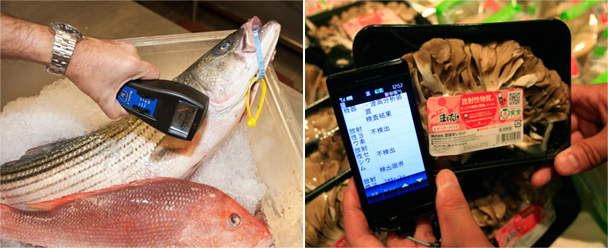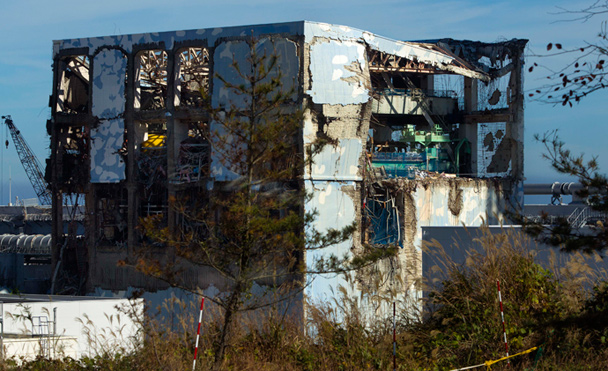After Japan’s Fukushima Daiichi nuclear power plant was left crippled by a triple reactor meltdown and multiple explosions in March 2011, Tokyo-based food giant Meiji took great pains to make sure its products were safe. Then, on December 6, the company recalled 400,000 cans of baby formula after tests revealed it to contain radioactive cesium, albeit at a level well within Japanese government safety limits.
According to company reports, the raw milk used to manufacture the formula predated the March 11 quake, and water used in the production tested clean. But the company had not monitored the air at its factory in Saitama prefecture, about 125 miles southwest of the nuclear disaster, thus allowing trace amounts of radioactive molecules to seep into the baby formula during the drying process.
Company officials and experts have pointed out that exposure to the formula will not have any adverse health effects, yet children—and especially babies—are particularly susceptible to cancer from radioactive exposure. In a statement, Meiji said it would replace the cans of formula so parents “can feel their infants are safe.” In the 10 months since Japan’s largest recorded earthquake and subsequent tsunami devastated the Fukushima Daiichi plant and triggered a series of radiation releases into the air, ground, and Pacific Ocean, the fallout on the Japanese food supply has been both real and imagined.
The disaster is the worst since the Chernobyl nuclear plant exploded 25 years ago, scattering hazardous levels of radiation on farmland in Ukraine, Belarus, Russia, and beyond. In Chernobyl, according to the International Atomic Energy Agency, a 19-mile radius around the plant known as the exclusion zone will continue to be uninhabitable for decades to come, and stubborn radioactive material, which takes decades to break down, is still measurable in some parts of Europe. According to the World Health Organization, many of the farming-dependent communities outside the exclusion zone face lasting obstacles from restrictions and stigmas that make their produce hard to sell.
By comparison, scientists have determined that the radiation release from Fukushima Daiichi is about a sixth as severe as that from Chernobyl. The Japanese government has said that a 12-mile radius around the 860-acre nuclear site will be uninhabitable for decades, forcing thousands of farmers who raise everything from cattle to corn to evacuate their land. Outside the zone, winds, rain, and snow pushed radioactive emissions from the plant—perched on the Pacific coast 150 miles north of Tokyo—into the ocean and northeast of Fukushima, initially affecting prefectures such as Ibaraki, Tochigi, Gunma, Kanagawa, and Chiba.
In the days following the quake, the Japanese government identified contaminated foods, halting sales and export of milk, fresh produce, and infant formula from affected areas and pulling products including meat, spinach, and teas with high radiation levels from shelves. Early on, scientists saw concentrations in milk and teas in the region that were at least five times the recommended limits.

Japan has a reputation for being on the forefront of food safety, having established stringent safeguards against mad cow disease after outbreaks in the 1990s, for example. But in the face of the unprecedented challenges Fukushima has presented, many Japanese found the early government response to be slow. It’s a viewpoint shared by Martin Frid, a Tokyo-based expert on Japanese food safety with the well-respected independent consumer watchdog group Consumers Union of Japan, which was critical of the government’s initial efforts.
“It took some time [to identify] where the plume of smoke had gone and what had been affected,” Frid says. “The government started testing, and the levels were not high. Outside of some river fish and some fluke places like some hot spots, the levels were below normal.”
Yet in July, contaminated beef that had reached plates across the country was found to have higher than normal levels of contamination. According to reports, the government responded by stepping up testing of hundreds of farms and determined that 14 had shipped more than 550 cows fed rice straw that contained more than 500 times the safe limit for radioactive cesium.
In November, several rice farms in Date, a city about 30 miles from the nuclear plant, were found to have twice the permitted levels of radioactivity, leading the Japanese government to expand testing to more than 2,300 farms in the Fukushima prefecture.
Last month, Fukushima Daiichi officials acknowledged that water contaminated with radioactive strontium was still leaking into the ocean nine months after the disaster, and local reports claim that, in total, more than 200 tons of highly radioactive water may have escaped from the plant—record levels of water-borne radioactive releases, according to The New York Times. On December 16, Japanese prime minister Yoshihiko Noda stated that radiation is no longer leaking from the plant’s perimeter, but reports indicate that with continued hiccups and uncertainty, public sentiment remains skeptical.
Pinning down the long-term effects of nuclear disasters is tricky. “It seems no one really knows…how much and for how long radiation will be an issue,” ventures Boston University professor Corky White, an anthropologist who has written extensively on food culture in Japan. “I think the lesson has been that we need to test, we need to measure,” Frid maintains. “There is public testing and private testing, and there are independent groups like Greenpeace.” As confidence in the government has been strained, consumer groups and citizens have taken matters into their own hands, buying $625 dosimeters to test food themselves. Concerns about milk and school lunches have emboldened and mobilized mothers to test, Frid reports. “People have a right to be worried,” he allows.
Initially, Japanese trade partners instituted restrictions on all food imported from Japanese prefectures affected by the disaster. Taking its cue from Japan, the U.S. Food and Drug Administration has slowly eased those restrictions, eliminating Gunma, Chiba, and Saitama from the list of banned prefectures. A look at recent FDA directives reveals the challenges Japan faces, with foods from affected regions—meat, mushrooms, tea leaves, yuzu, and more—being added to and taken off the export list.
The Japanese government has been calculating losses to farmland, produce, livestock, and fisheries regularly since the disaster. As of early December, the six northern prefectures primarily affected by damage from the earthquake, tsunami, and nuclear disaster had suffered billions of dollars in losses to agriculture. Some examples include $5.15 billion in losses of unusable farmland, $180 million in destroyed crops and livestock, and $740 million in damage to the farm fishing industry. The numbers are relatively small compared with Japan’s national production but are significant for the region. Tokyo Electric Power Company—the plant’s owner—and the government have been compensating farmers for their losses, not only to ease the pain of lost assets and wages but to ensure that tainted foods don’t find their way into the food supply.
“We don’t know the full extent of the cost,” Frid maintains. “I think we are still in crisis mode.” In the meantime, farmers and scientists have been looking for solutions. One idea was to remove agricultural topsoil, in case of contamination. Volunteers helping farmers restore the soil have found that if the top layers of soil—even only 5 centimeters—are scraped away, the radiation levels are cut dramatically, White notes.
Another approach is deep tilling, which disperses radioactive material and can play a part in reducing hot spots, according to Kathryn Higley, a radioecologist at Oregon State University. Healthy soils can help bind radioactive cesium, she notes, keeping it from being taken up into plants. “I expect over the next few years, you will see substantial gains to remove materials. I think a large driver of this is that this is intensely useful farmland,” Higley contends. “That’s my speculation. They want to bring that land back into production—they don’t want to cordon it off and let it sit.”
Could Fukushima fallout—and related long-term health concerns—force Japan to fundamentally rethink the way it eats? “My guess is that it will not, that Japanese foodways will continue to be seen as healthy and important to preserve, and that the culinary mix will always contain the products and dishes of the regions of Japan,” White maintains. “Fish have already begun to show lower levels of radiation effect, well below the safety ceilings.… What might happen, however, is a rise in interest in organic and sustainable farming—already a strong influence—which will set new patterns of cultivation.… I don’t want to paint too pretty a picture, but I see recovery of the ecosystem and maybe an enhanced new picture of farming in Japan in some relatively near future.”
Pervaiz Shallwani is a Brooklyn-based journalist whose work straddles the worlds of food and hard news. He writes frequently for The Wall Street Journal and has also been published by the Associated Press, The New York Times, and Rolling Stone. You can find him at PervaizShallwani.com and on Twitter at @Pervaizistan.

